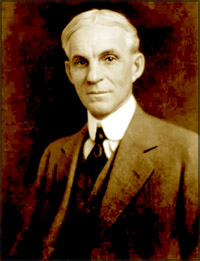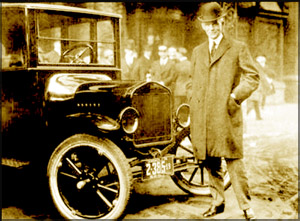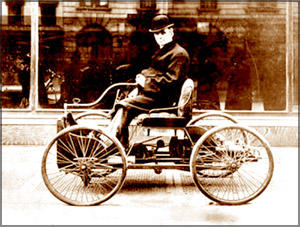|
I
n
t
h
e
l
i
m
e
l
i
g
h
t |
Henry
Ford:
Revolutionary inventor
 When
we talk about transportation and motorcars, one name that immediately
springs to mind is Henry Ford. When
we talk about transportation and motorcars, one name that immediately
springs to mind is Henry Ford.
He was the father of the modern assembly lines used in the mass
production of motorvehicles (this assembly line could finish a car in 98
minutes, at a lower cost than was possible then). His introduction of
the Model T automobile revolutionised not only the transportation
sector, but also American industry.
Not only that, he was an inventor of many other products and was
awarded 161 US patents (sole right to invention or process) . Ford was
the founder of the Ford Motor Company of USA, which is synonymous with
the motoring industry, and through his inventions, became one of the
richest and best-known people in the world.
Henry Ford was born on July 30, 1863 on a farm in Michigan. His
father was William Ford and his mother was Mary Litogot Ford. His
siblings were Margaret, Jane, William and Robert.
Henry's passion(strong enthusiasn or interest) for mechanics started
very early in life with the pocket watch his father had gifted to him in
his early teens. At 15, he had earned a reputation as a watch repairman,
having dismantled and reassembled timepieces for many of his friends and
neighbours.
His mother's death in 1876 devastated the young boy. Although his
father expected him to eventually take over the family farm, Henry
didn't like farm work. In 1879, he left home for the nearby city of
Detroit, Michigan, to work as a trainee machinist.
He married Clara Ala Bryant in 1888, and supported himself by farming
and running a sawmill. They had a child, Edsel Bryant Ford and also
adopted another one from China.
|

Henry Ford with his Model T |
In 1891, Ford became an engineer with the Edison Illuminating
Company, and after being promoted chief engineer in 1893, it was
possible for him to spend time and money on his experiments on gasoline
engines. These experiments resulted in the completion of his
self-propelled vehicle named the Quadricycle in 1896.
Ford incorporated the Ford Motor Company in 1903 with 11 other
inventors and started offering higher wages, which resulted in the best
mechanics in Detroit flocking to the company, bringing in their
expertise, raising productivity, and lowering training costs.
With these Ford built a huge factory that shipped in raw materials
and shipped out finished automobiles.
The Model T was introduced on October 1, 1908. It had many important
innovations which were soon copied by other manufacturers. The car was
simple to drive, and easy and cheap to repair.
The network of local dealers made the car available in virtually
every city in North America. Always on the lookout for higher efficiency
and lower costs, Ford introduced the moving assembly belts into his
plants in 1913, which resulted in a rapid increase in production. By
1918, half of all cars in America were Model Ts. In 1918, he turned over
the presidency of the company to his son Edsel.
By the mid-1920s, sales of the Model Ts had begun to decline due to
rising competition and by 1926, despite initial
|

The Quadricycle
|
reluctance, Henry decided to make a new model car - which was
the successful Ford Model A, introduced in December 1927 and produced
through 1931, with a total output of over four million automobiles.
Despite being an industrialist, Ford treated his workers well and
introduced many measures to improve their lot such as reducing the daily
working hours from nine to eight hours, a five-day work week, and a
raised minimum daily pay. Some of these measures were heavily criticised
by other industrialists of the era.
Ford, like all other automobile companies, entered the aviation
business during World War I, building Liberty engines and played a major
role in the Allied victory although he was always against war. After the
war, the company returned to auto manufacturing until 1925, when it
acquired the Stout Metal Airplane Company.
Ford believed in economic independence for the United States and also
that international trade and cooperation led to international peace. He
opened Ford assembly plants in Britain and Canada in 1911, and soon
became the biggest automotive producer in those countries. Italy,
Australia, India and France were some of the other countries where Ford
factories were opened. By 1932, Ford was manufacturing one third of all
the world's automobiles.
Not being satisfied just producing commercial cars, Ford began a
career as a race car driver in 1901. In 1913, he dropped out of racing
permanently, citing dissatisfaction with the sport's rules and the
demands on his time by the booming production of the Model Ts. After
Edsel's death in 1943, Henry re-assumed day-to-day control of the Ford
Motor Company.
Ill health prompted him to give up the presidency of the company to
his grandson Henry Ford II in 1945 and go into retirement. He died in
April 7, 1947 of cerebral(brain) haemorrhage at age 83 in Fair Lane, his
Dearborn estate, and was buried in the Ford Cemetery in Detroit. |
